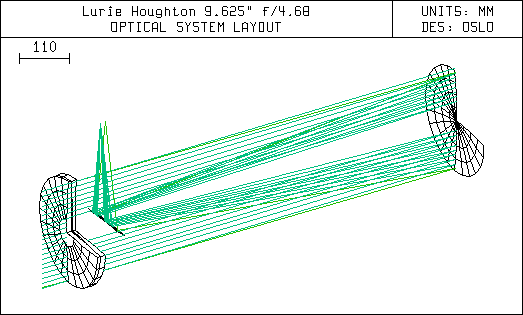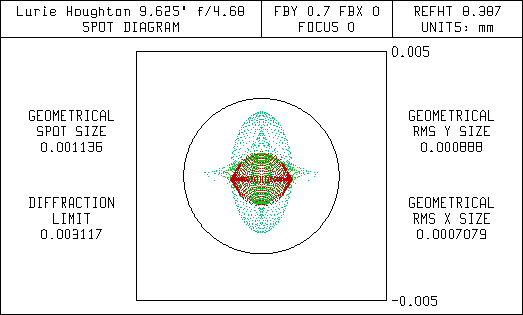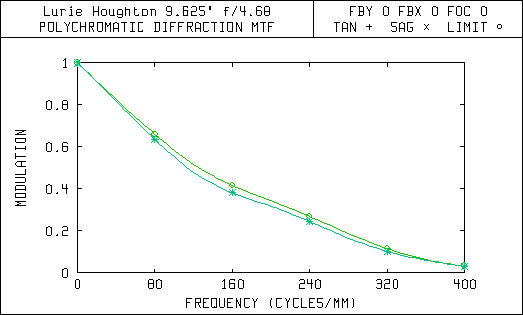OSLO LT V5.4
Optics Software for Layout and Optimization
by Rick Scott
Has anyone out there tried to raytrace a telescope design? How about analyzing the performance of their scope or maybe one they would like to build. Raytracing software works by analyzing the path that light takes to traverse the optical system. Many paths are traced and these are referred to as rays. As each ray passes through or is reflected by an optical surface, the program changes the direction the ray travels using optical principles such as Snell's law. Rays can be blocked by an obstruction or even pass outside the boundaries of the optical surface. If the optical system focuses the light, the rays that make it through the system will converge at the focus. The pattern these rays make is called the spot diagram and can show the effects of aberrations such as coma and astigmatism. By counting the number of rays that make it to the focus and dividing by the number of total rays used in the analysis, the percent transmission can be calculated. This is useful to plot the vignetting of the system.
Recently, I've been working on the design of a telescope and during the initial stages I spent some time perusing the Amateur Telescope Making Archive web site. I was looking for information on the telescope type I've chosen and found discussions on various raytracing programs. The one that seemed to have the best performance (i.e. accuracy) was OSLO LT from Sinclair Optics. I downloaded the software, which is a free version of their high-end optics design tool. The limitations in the LT version are, the number of optical surfaces is limited to 11 plus the image plane and only 50 variables may be used in the optimization engine. For most telescope designs, these are not a concern.

I was able to do some analysis after a couple of days, but it took me about a month of reading the user guide and help file to figure out most of the program. The learning curve was worth every minute. OSLO LT can analyze just about anything you could want besides performing raytracing. You can generate the following analysis both on and off axis:
o Spot Diagrams (with or without a diffraction limit circle)
o Point Spread Function
o Optical (Modulation) Transfer Function
o Wavefront Analysis (peak-to-valley and rms)
o Diffraction and Geometric Energy Distribution
o Diffraction and Geometric Line Spread/Knife Edge Distribution
o Beam Footprint
o Distortion
o Ray Intercept Curves
o Longitudinal Spherical Aberration
o Astigmatism
o Chromatic Focal Shift
o Lateral Color
o 2-D and 3-D (from any angle) drawings of the optical system
o And much more!
OSLO LT keeps track of the optical path length each ray travels, so it knows the phase relationship of the light as it travels through the telescope. It uses this information to calculate diffraction related effects and aberrations. It can overlay a circle on the spot diagram that shows the diffraction limit (or Airy disk) for the particular optical system. If all of the rays fall within the circle, the performance of the scope is considered to be diffraction limited. One thing I learned in studying various telescope configurations is that fast Newtonian scopes, even with textbook perfect paraboloidal mirrors, are diffraction limited for only about a 4 arc-minute diameter field of view!!

The data for each surface of the design is entered in a spreadsheet format for radius of the aperture, radius of curvature of the surface, thickness (or spacing), surface type (air, type of glass or reflection), type of aperture, (round, square, transmit or obstruct) and special attributes such as ideal lens, aspheric coefficients, diffractive surface or gradient index of refraction. All of the surfaces can also be tilted or decentered, so making a Newtonian or Schiefspiegler configuration is easy. High order surfaces can be entered which allows for the analysis of designs using Schmidt correctors. Besides surfaces of revolution, OSLO LT also has cylindrical, toroidal, spline, fresnel and other surfaces, for those with a different bent! The image surface can also have a radius of curvature to investigate the effects of field curvature.
The analysis can be performed for any single or combination of wavelengths of light by entering the wavelength in microns or selecting from a pull-down table. The table contains standard wavelengths that are commonly used in optical design along with their light source type if applicable, such as He-Ne laser, Argon, Hydrogen, etc. OSLO LT contains an extensive library of glass types to choose from for lens elements, or you can make up a custom glass type. It also contains a large library of common lenses available from some commercial optical companies. Sample files that come with the program cover a wide range of optical systems, including a Schmidt camera and the Hubble Space Telescope.

In addition to generating all sorts of graphical output, various textual analysis can also be generated. Some of the useful data from these include the actual working focal ratio, percent ray transmission (great for making vignetting curves), Strehl ratio, and the Seidel aberration coefficients.
I was able to use OSLO LT to replicate the graphs and data in the telescope design bible, Telescope Optics by Harrie Rutten and Martin van Venrooij. The software runs on Windows 95 and up, and is very well behaved. Many of the functions are written in the SCP (Star Command Programming) language, the OSLO macro programming language, which is very much like C. This allows advanced users to modify existing functions or to write their own routines to add functions that currently don't exist. Any of the text or graphics output can be printed or captured to the clipboard to paste into other applications.
Through the use of OSLO LT, I've been able to refine the optical design of the telescope I'm working on. Many what-if's can be checked by varying the curvatures, spacing, tilts and centering of the surfaces to determine how sensitive the design is to variations. After extensive analysis and just fooling around, I now feel very confident that when my new telescope is completed, it will work very well.
I highly recommend that you download and learn OSLO LT if you're interested in some truly graphic demonstrations (pun intended) of optics or just want to learn more about optical design through computer based experiments. Best of all, this software is extremely useful if you're designing or modifying a telescope.